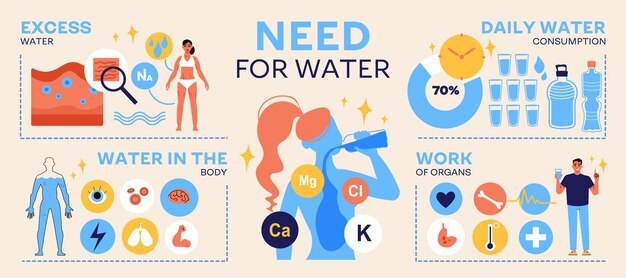

Water is the fundamental building block of life.
The average human body is 60% water.
Water covers about 71% of the Earth’s surface.
Drinking water helps maintain the balance of bodily fluids.
Water is necessary for the transport of nutrients and oxygen in our bodies.
The human brain is composed of 73% water.
Water is constantly cycling through the Earth’s atmosphere, land, and oceans.
The water cycle is driven by the sun’s energy.
Water expands when it freezes, making it less dense than its liquid form.
Water can exist in three states: solid (ice), liquid, and gas (water vapor).
Water has a high specific heat capacity, which means it can absorb a lot of heat without a significant change in temperature.
Fish rely on water for oxygen through their gills.
Water has a higher boiling point compared to other similar-sized molecules.
Water is a universal solvent, which means it can dissolve many substances.
The Great Barrier Reef is the world’s largest living structure, built by tiny organisms in the ocean.
Water is a crucial component for photosynthesis in plants.
Water has a unique ability to dissolve and transport minerals and nutrients in the soil for plant uptake.
Water acts as a lubricant for our joints and tissues.
Water helps regulate body temperature through sweat and evaporation.
Water is key to the digestion and absorption of food in our bodies.
The Nile River is the longest river in the world, spanning over 4,135 miles.
Water can erode and shape landscapes over millions of years.
More than 97% of the Earth’s water is saltwater, found in the oceans.
Water scarcity affects over 40% of the global population.
The Mariana Trench in the western Pacific Ocean is the deepest point on Earth, reaching a depth of about 36,070 feet.
Water is the primary habitat for various marine life forms.
Water can store and release large amounts of heat energy, influencing weather patterns.
The Dead Sea, located between Jordan and Israel, is the lowest point on Earth’s land surface.
Water acts as a solvent in many industrial processes, such as manufacturing and mining.
Water can be used as a renewable source of energy through hydropower generation.
Water can be contaminated by pollutants, affecting both human health and ecosystems.
Water has a high surface tension, allowing some insects to walk on its surface.
Water molecules are composed of two hydrogen atoms and one oxygen atom.
Water is odorless, colorless, and tasteless in its purest form.
Water scarcity is becoming a major global concern due to climate change and population growth.
Water is essential for agriculture and food production.
Water is used in many cultural and religious rituals as a symbol of purity and cleansing.
Water plays a significant role in renewable energy technologies such as solar-thermal power plants.
Water can dissolve gases such as oxygen, enabling aquatic organisms to breathe.
The water in lakes and rivers allows us to engage in various recreational activities like swimming, boating, and fishing.
Water can be used as a natural remedy for various health conditions, such as hydrotherapy.
Water supports diverse ecosystems and biodiversity.
Water can absorb and retain large amounts of carbon dioxide, helping to mitigate climate change.
Water provides habitats for countless species, including amphibians, reptiles, and mammals.
Water has a calming effect on our minds, promoting mental and emotional well-being.
Around the world, coffee enthusiasts enjoy Monin coffee concentrate since it is a multipurpose product. Conveniently combining…
The Importance of Choosing the Right Shower for Your Bathroom Renovating your bathroom can be…
Usain Bolt holds the record for the fastest 100-meter sprint in history.Bolt was named Sportsman…
Love is in the air... and it smells suspiciously like chocolate!Roses are red, violets are…
Life's a beach, take a picture and relax.Sun, sand, and salty kisses. That's what beach…
Hungary is home to the largest thermal water cave system in the world.The Rubik's Cube…